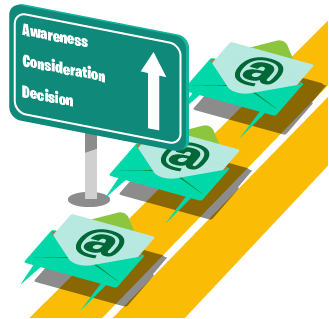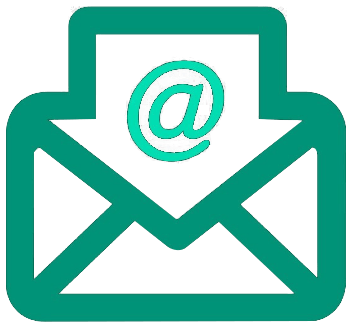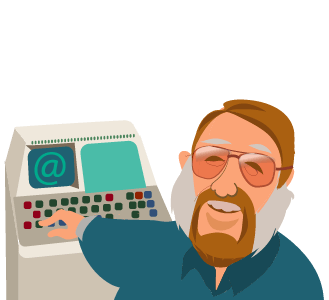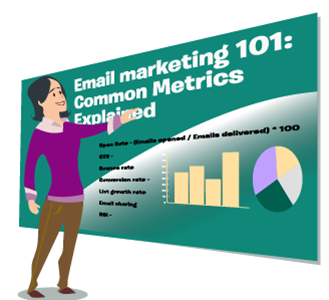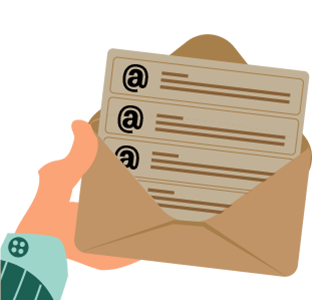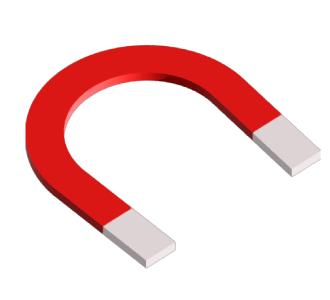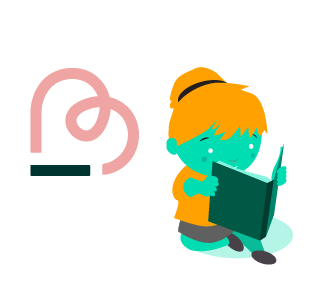When you have spent hours planning the perfect email campaign, it’s easy to develop tunnel vision. You sank so much time and effort optimising your emails that you lose sight of the big picture.
You think your readers care about what you have to say but turns out they’re coming from a completely opposite angle – they don’t care about your message and nothing in your email interests them.
With the number of digital buyers predicted to reach 2.05 billion by 2020, it is now more vital than ever to produce email campaigns that teach, inform and most importantly, influence your prospects into buying your products or services.
That’s where an email journey map can help you.
A recent survey reveals that B2B business uses email as their main driver to bring leads through their sales funnel.
And yet, I realised that most of my clients find it a challenge to develop targeted content via email.
That’s what this guide is for.
I hope I can walk you through the process of mapping your own email journey map from start to end, and hopefully, you’ll take away some useful tricks and tips by the time you finish reading. I’ll even provide a few templates to help you get started.
But first, a quick background about myself
I’m Murray Dare. And I’ve been in Digital Marketing for 10 years, where I help businesses with their SEO and PPC, website conversion optimisation, and website development.
I have built websites from scratch, led web development teams and managed large redesign and migration projects for big clients.
If you feel lost or if you need some advice on your planning your email journey map, do drop me an email and I’m here to help you achieve better marketing results for your business.
Get ready, because this is going to be a long article. So get comfortable and dive right in!
So what exactly is Email Journey Mapping?
Email journey mapping (or sometimes known as email response mapping) is an incredibly useful tool for crafting your email subscribers’ experience.
Without going overly technical, email journey mapping is simply a way for marketers map out the journey customers have when they are communicated by your company’s emails.
Imagine your company sells circus stuff, and a customer has just signed up to get your free guide to juggling. What emails are you going to send in what order and how often?
Email journey mapping is about planning how to drive your customer exactly where you need them to go, in a smart and concise way.
Working out whether you should send 1, 2, or even 10 emails, deciding if they are related, and working out which order, style of email content is going to drive your sales.
This can be done from a buyer’s perspective, a guide, engagement emails or even retentions.
Today, email campaigns aren’t longer just carpet-bombing monologues. They have become ongoing conversations where businesses bond with users. And email journey mapping is all about finding a more effective and personal approach.
Ultimately, you’ll want your emails to convert prospects, and to develop lifelong relationships with your existing customers.
Email Journey from a Buyer’s Perspective
Your buyer can belong to one (or more) of the following:
- Someone who has bought from you and you want to send them related products, g., a customer who bought a home theatre, you wish to sell them flatscreen TVs.
- Someone who has explicitly expressed interest in your products, g., a prospect subscribes to your email newsletter
- Someone who you haven’t contacted in a while, g., a customer who bought a product with a long life cycle like a washing machine.
- Someone who is coming to the end of their yearly subscription and you want them to renew, E.g., a magazine subscription
- Someone who has downloaded a guide, and you want them to purchase, g., a subscriber to your blog; you wish to market your online course to him or her.
Therefore, the buyer’s journey represents the process that prospects undergo before they become a full-fledged customer.
It can be crafted into a deeply personal experience for your audience if you do it right. Ideally, you’ll become a trusted advisor to your audience, and you will be selling your product without lifting a finger.
A buyer’s journey can be made up of anywhere between 3 to 15 stages, depending on which marketing school of thought you’re following.
To keep things simple, let us stick to a 3-stage journey:
1. Awareness
2. Consideration
3. Decision
As you would have guessed by now, mirroring your email journey closely to a buyer’s perspective is the key to conversion success.
Journey Step #1 Awareness Emails
Awareness emails are that you send out to let your readers know your presence.
Even though they have already subscribed to your list, they may not remember it. Or they may be unaware of how your product or services can do for them.
The goal of awareness emails is not to push your readers to buy. Instead, it is to teach, inform and even entertain your readers. This way you will maintain a level of presence in your audience’s mind.
In marketing, we call this the top-of-mind awareness (TOMA).
Let me give you an example:
You sell ergonomically designed office chairs. A prospect has been suffering from sore neck while working in his office for weeks.
After Googling the symptoms and remedies, he realises that he has a chronic sore neck problem, and he needs to change his office seat to a high quality and well-designed chair.
So the prospect stumbles upon your site, registers to your email list, but somehow decides not to buy your chair immediately (maybe because of the price tag).
So here’s what you should do – You should not be sending an email to him reminding of the benefits of your medically-approved, ergonomically-crafted luxurious office chair.
Instead, you should be crafting emails that have value to the prospect, such as quick office remedies for sore necks or talk about standing vs. sitting at your work desk.
Some other good examples include:
1. An ebook pdf to curing sore necks
2. Tips on curing back problems (since neck ache sufferers usually suffer from backaches as well)
3. A personal story or case study that is related to your prospect’s issues (how changing your grandma’s bed helped solved her back and neck problems).
The key is to provide as much free information as you can that your reader will find helpful, without selling yourself.
Become the go-to-authority on the subject matter (in this example, an expert in office ergonomics), and soon you will become a brand your audience will trust.
Ok, let’s now look at how we can create awareness emails.
1. Find out what are the triggers
In marketing, a trigger refers to an event that pushes a prospect’s need for a product or service.
An easy way to identify triggers, which I like to use, is to think about a recent problem that I encountered. I find that when I share stories to my readers, they find it easier to relate to me.
Even if you don’t have any personal stories, the web contains a wealth of research information that you can tap into.
Facebook groups, niche forums, Quora, and even Amazon reviews can be a treasure trove of information into the insight of your potential clients. Your prospects may raise or discuss issues and concerns that have been bugging them, which you can use as topics for your emails.
Identifying triggers are a great way to target clients that don’t even know you exist. A marketing practitioner should be able to sit down together with you and help you identify these triggers, to optimise your email campaign journey.
2. Research on your existing customers
Your customer base is another goldmine of market data that you can uncover.
If you already have a large customer base, talking to them is usually the best way to go. You should ideally collect a mix of quantitative and qualitative data.
Quantitative data refers to data that is measurable (number of sales, average number of lifetime purchases, etc.), whereas qualitative data refers to data that can’t be measured (why your subscribers removed themselves from your mailing list, etc.).
Both types of data have different advantages, but in general qualitative data lets, you gain more insight into your clients’ behaviour or psyche.
Some good questions you should be asking your existing customers are:
-
- How would you describe yourself?
- Where exactly did you first hear about us?
- What’s the biggest thing we’re missing?
- What’s the greatest challenge you’re experiencing now?
- What are the top three concerns that almost stopped you from choosing our brand?
- What happens if you don’t solve the challenge you’re facing?
Gathering info from your customer base can be as simple as a popup survey on your website, or an email that contains a Google Form survey.
For data collection on a more massive scale (100 or more respondents), you can use software like Typeform, or consult a marketing expert to plan your data collection process.
3. Create a customer avatar
Once you have gathered enough data, you should be able to recognise recurring trends. Using this insight, you should be able to create a prototype of your typical customer, or a customer avatar.
A customer avatar (or more commonly known as buyer persona) is a great way to visualise your typical customer to decide what emails to send.
With a customer avatar available, your readers should become much more receptive to what you have to say.
To put it in an example, one of my previous clients is in the business of selling exercising programs that target older men aged 50 and above.
Initially, we were writing email content that is targeted at 50-year-old married men looking to stay active. But after running a survey, we uncovered something totally different.
We realised that most of our client base are men who are either divorced or unhappily married.
It turns out, the majority of our buyers were looking to reignite their relationships with their spouse by getting in shape. Some are even looking to get back in the dating game, which is why they bought the exercise programs – to look good again.
So, with this new insight, my client and I went back to the drawing board and changed our customer avatar. After tweaking our email content, we began to see a dramatic increase in conversions!
Journey Step #2: Consideration
Let us go back to our office chair example.
By now the prospect has already know what he needs to solve his pain – a new office chair. However, at this point in time, he doesn’t know what his options are.
He will be evaluating and weighing his choices, by researching and understanding all the options available to him.
This is where consideration emails come into play – they help to nudge the prospect towards the right direction.
Now here’s the important part – if you did not carry out Step 1 properly, you wouldn’t be able to see the results in step 2. That’s because your readers are not feeling compelled to go with the flow because he or she hasn’t recognised you as an authority yet.
On the flip side, if you have executed step 1 perfectly, you’re going to see your readers start to respond really well to your consideration emails.
A good way to create consideration emails is to display social proof by using testimonials– send emails that talk about how your clients love your office chair, how it has helped solved their neck and back pains.
Remember, you’re not asking for a sale. You are just inviting your prospect to engage further with you.
Journey Step #3: Decision
After going through the research process and eliminating all his options one-by-one, your prospect has narrowed down his buying choices to one – your product.
This is the last stage of the journey, which is also called the decision stage.
At the decision stage, not only has your prospect whittled down his options, he wants information – how your product works, what happens after they make the purchase, and what experience they can expect.
Give what your prospects want. Give them every bit of product specification, table of comparison, shipping weight information, even the shipping costs.
This is also the stage where prospects need validation for their decision. They need to feel that they are making the right choice; they need to rationalise their buying decision.
Providing ample amounts of product information can help to solidify their purchase.
It is at this stage you can send emails to your audience, informing them of additional benefits that they may have missed – discount codes, free shipping, etc.
You can even sweeten the deal by offering free returns or free trials for your product or services.
Once your prospects realise they have nothing to lose for taking the plunge, they will feel compelled to hit the ‘Buy now’ button.
6 templates for creating your own Email Journey Maps
It’s going to be a bit of a challenge to build your own journey maps from scratch. After all, email journeys can be similar, but no 2 are exactly the same.
I’ve included these templates which should help you get started. They are based on some of the most common journey maps I’ve worked with. They should give you a nice framework for a solid brand experience for your audiences through email.
1. The Subscriber Journey
A visitor of your website opts in to get your emails regularly.
What’s next? The objective of this journey is to put new subscribers at ease and give them a glimpse of what your brand is all about. This is the birth of a new friendship, so put out your best content and make your new subscriber feel welcomed.
JOURNEY DELIVERABLES
A welcome email: An autoresponder that gets sent right after the subscription.
Newsletters: Regular newsletters (daily or weekly) that get delivered to your subscriber’s inbox.
Your email program is likely to be made up of mostly informative and product emails. You should also add a few extra emails to your welcome journey, like offering discount codes to new subscribers or surveying subscribers about their inclinations so you can tailor your emails to make them relevant.
2. The Lead-Nurturing Journey
Once somebody raises their hand and turn into a lead, you should immediately move them through the sales funnel with the help of relevant content. The objective of the lead-nurturing journey is to warm your leads up and reinforce their connection with your brand.
JOURNEY DELIVERABLES
- Email 1: Sharing a helpful cornerstone post from your blog
- Email 2: Offer an ebook, case study, or video that solves a problem that is bugging your leads
- Email 3: A free trial or consultation offer for your product
You should coordinate your sales effort on the timing for this journey. Spread your email frequency between alternate days formula is a great idea as you won’t end up overwhelming your lead.
Lead nurturing takes time to develop. The key is to make the readers feel you are putting their success ahead of your interest.
So if you have the helpful content resources, don’t hesitate to share them! But also try turning up your lead warming efforts by sprinkling some highly targeted product endorsements, satisfied customer case studies, and product deals in between your content email.
3. The Hot Lead Journey
When there is a white-hot lead in your hands, stop wasting time. You should be using a hot lead journey to hold on to their engagement and quickly convert them into a buyer when an opportunity arises.
JOURNEY DELIVERABLES
- Email 1: Sharing a successful case study, customer reviews, and testimonials, or an in-depth ebook on a topic that is highly relevant to your reader’s pain point
- Email 2: A free trial or consultation offer for your product
- Email 3: A follow-up email to schedule a call (if they choose to accept the free offer in email 2)
Your sales team should be able to provide timing recommendations based on their experience. The key is to reduce the risk your lead losing interest by dragging too long between emails, but too quickly and you come across as hard-selling.
If a lead is hot, sweeten the deal with a first-time purchase discount.
Or better yet – if they added their product to their shopping cart but left without buying, send out a discount code in a highly targeted abandon cart email to wrangle them back.
4. The Cold Lead Journey
It is natural for leads to grow cold on us. Leads grow cold for any number of reasons, but that doesn’t mean they have become a lost cause.
Cold leads may still be interested in your brand or what you’re offering. Using a cold lead journey can relight the fire and turn cold leads warm again.
JOURNEY DELIVERABLES
- Email 1: Share a new piece of content that speaks about a pain point they’re experiencing
- Email 2: Share new info or updates on your brand since they last responded. They can be new features, upgrades, products, additions to the team, etc.
- Email 3: Another free trial or consultation offer for your product
You can set this journey to auto-respond to any subscriber who hasn’t responded to your email after a certain amount of time. The aim is to come across naturally concerned, so choose alternate days to send your emails.
As with lead nurturing journey, the key is not to overwhelm your target. I would suggest 2 to 3 short pauses then followed by a long pause, keeping pauses between 6 to 45 days.
You can also try sending out a limited offer to generate urgency around a product they are interested in.
5. The New Customer Journey
Great work! Your prospect has officially become a customer.
But don’t stop now, it’s time to impress your new buyers and move them down the path to becoming loyal ambassadors for your brand who will share your product far and wide, through social media and word-of-mouth.
JOURNEY DELIVERABLES
- Email 1: An email expressing your gratitude, welcomes them to the family, and lets them know what to expect
- Email 2: An email that checks on their well-being, asks for feedback/issues with your product (such as surveys).
- Email 3: After they’ve been a customer for some time, share a new product or service you that is related or likely to interest them (the opportunities to cross-sell is high).
Send them the welcome email immediately after their purchase. Hold on for a couple weeks before sending the second email, then a couple months before sending Email 3.
If they haven’t already opted-in to receive your emails, deliver a 2 punch combo by adding them to your subscriber journey as well, so they won’t miss any future updates or promotions.
5. The Product Launch Journey
You have a new product waiting to be unveiled, and you need to build up hype for your new product.
Building hype with pre-launch email journey can be a highly-converting method to generate sales. This is the kind of journey where you keep your readers curious, using multi-part emails that allude to something exciting to keep them curious for the next email.
JOURNEY DELIVERABLES
- Email 1: An email that talks about the upcoming product
- Email 2: An email that talks about successful case studies, customer reviews, and testimonials from customers of the previous product. And talk about why the new product is an improvement of the previous version
- Email 3: A free preview of the new product. It can be a webinar video, a demonstration, or a trailer.
- Email 4: An early bird discount code on the eve of the launch date
It’s a good idea to create urgencies, such as using a countdown timer or with limited discount coupons. The timing between every email should gradually ramp up as you get closer to the launch date of the new product.
Sometimes I may even opt to send 2 emails a day, so as to keep the hype in momentum.
After your product is launched, you can continue this journey with a post-launch journey. It’s the same journey but in reverse – the focus of the emails should be about the new product, and the timing should go from frequent to less frequent.
Some more tips for building successful Journey Maps
Successful journey maps involve beyond the inclusion of the “right” components. Journey mapping should be a well-thought-out process outlined by well-defined goals, based on solid research work.
It requires hard work to keep the process on the right path and to build the loyalty among your readers. Here are a few more tips for making sure that your email journeys start and stay in the right direction:
1. Fall back on your customer avatar. If you find yourself getting lost on what emails to send, it’s always good to go back to your customer avatar and put yourself in their shoes. Ask yourself:
o What end goal does this journey map provide?
o Who are my readers?
o What are my readers pain points and does my content address them?
2. Base it on truth, not fiction. Readers nowadays are not ignorant. With a wealth of information at their fingertips, they can easily verify tall tales with a Google search.
Journey maps should be truthful narratives, not fairy tales. Start with gathering any existing research and back them with facts.
This is where qualitative data and case studies can come into play. Use your previous experience and data to build a narration that will keep your readers interested.
3. Collaborate with other people. Mapping your email journey is a valuable process. If your organisation is large, you should involve more stakeholders, like the sales team. Invite them to take part and contribute their own research data for your map.
Conclusion
So there you have it – I’ve provided you the know-how and the templates needed to get started. I hope you’ve learned some valuable insights into planning your email journeys from this guide.
Your email list is undoubtedly one of the most prized resources in your business. It can literally become a money making machine for your business if you put in the time and effort to plan your email strategy properly.
Remember, offering constant value is the key to converting your readers into brand ambassadors for your business, which is something any business can profit from.
If you need any help or advise in mapping your email journey, drop me an email and let’s have a chat!
